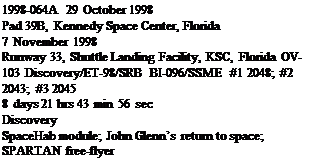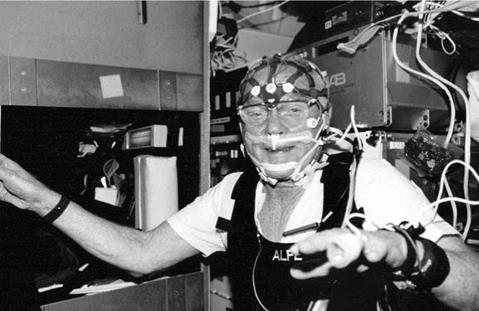. SOYUZ TM28
Flight Crew
PADALKA, Gennady Ivanovich, 40, Russian Air Force, commander AVDEYEV, Sergei Vasilyevich, 42, civilian, flight engineer, 3rd mission Previous missions: Soyuz TM15 (1992); Soyuz TM22 (1996)
BATURIN, Yuri Mikhailovich, 49, Russian Air Force, cosmonaut researcher
Flight Log
Before becoming a cosmonaut, Yuri Baturin had been a space physicist. He then became the national security advisor for President Boris Yeltsin and then the Defence Council Secretary. He was also an advisor on space matters and was attached to the 1997 Air Force cosmonaut selection (with the rank of colonel). In April 1998, he completed a 12-day mission to Mir, returning with the EO-25 crew. After his mission he stated that, in his opinion, the Mir complex should be kept operating for at least two years beyond the planned 1999 decommission date.
When Baturin and the E0-25 crew departed Mir, the two remaining cosmonauts pursued their EO-26 programme. This included an internal EVA inside the forward node to reset electrical connectors inside the Spektr module. Their subsequent 10 November EVA (5 hours 54 minutes) featured the deployment of Japanese and French experiments. They then continued their programme of experiments, many of which had been left on board the station by international visitors, enhancing the return from the investment in those experiments.
Mir was almost forgotten in the wake of the launch of the first element of ISS – the Zarya module – in November. This was followed by the first Shuttle mission to add other elements – the US node Unity – the following month. With ISS in orbit, Russia indicated that it was looking for private funds to keep Mir aloft into the new
|
The Soyuz TM28 crew included Baturin (left), a former advisor to President Boris Yeltsin, along with Padalka (centre) and Avdeyev |
millennium, as governmental support would end in 1999 when its commitment to ISS increased. When news came that the Service Module of the new station (Zvezda) would be delayed into 2000 and with it the capability of supporting a resident crew, the call to maintain Mir operations beyond 1999 intensified. There was also discussion about further commercial ventures for the station, including filming part of a movie aboard Mir with actors making a short visiting mission to film scenes in orbit. With news that a new investor might support further use of Mir, there remained the question of fitting in the two missions already planned as the EO-26 residence drew to a close and Mir funding from the government ended. The two options were to either fly a Russian commander with the French flight engineer to see out the planned programme, or to leave Avdeyev aboard Mir to join the Russian and French crew members, making a three-person crew for the remainder of the government-funded occupation of the station. The subsequent Slovak mission could then be launched with the new crew and return with Padalka on TM28.
In the new year, the cosmonauts continued their science programme as news came in that the life of the station was to be extended three years (to 2002), if sufficient nonbudgetary (government) funds could be found. This allowed Energiya to tentatively plan a programme through to 2001. Just weeks later, the news came that the “private investor” had pulled out. The EO-27 crew launched in February 1999 were expecting to be the last crew to man the station.
Milestones
208th manned space flight 87th Russian manned space flight 80th manned Soyuz mission 27th manned Soyuz TM mission 26th Mir resident crew
33rd Russian and 71st flight with EVA operations
Avdeyev celebrates his 43rd birthday (1 Jan) on Mir – the third birthday he has spent in space (previously 1993 and 1996)

 |
Flight Crew
BROWN Jr., Curtis Lee, 46, USAF, commander, 5th mission Previous missions: STS-47 (1992); STS-66 (1994); STS-77 (1996); STS-85 (1997) LINDSEY, Steven Wayne, 38, USAF, pilot, 2nd mission Previous mission: STS-87 (1997)
ROBINSON, Stephen Kern, 43, civilian, mission specialist 1, 2nd mission Previous mission: STS-85 (1997)
PARAZYNSKI, Scott Edward, 37, civilian, mission specialist 2, 3rd mission Previous missions: STS-66 (1994); STS-86 (1997)
DUQUE, Pedro Francisco, 35, civilian, mission specialist 3 MUKAI, Chiaki, 46, civilian, payload specialist 1, 2nd mission Previous mission: STS-65 (1994)
GLENN Jr., John Herschel, 77, US Senator, payload specialist 2, 2nd mission Previous mission: Mercury 6 (1962)
Flight Log
John Glenn, the first American astronaut to orbit the Earth in 1962, had always wanted to return to space. But he had not expected that it would take over 36 years for him to do so. While pursing a business and political career, Glenn had always maintained a close relationship with NASA and had convinced NASA administrators that a set of medical experiments looking at the effects of microgravity on an older person would be of benefit to the near – and long-term goals of the agency. It would also provide an interesting set of comparison data with that taken during his first flight in 1962. Glenn first approached NASA with the idea in 1996, but it took two years to develop the experiment programme and obtain formal authorisation. The flight was also a public relations triumph for the space agency and a swansong of Glenn’s career in public life.
|
|
US Senator and former Mercury astronaut John H. Glenn Jr., equipped with sleep-monitoring equipment, floats near his sleep station on the mid-deck of Discovery
The launch progressed smoothly, with only minimal delays caused by a master alarm in the cabin and an aircraft infringement in the restricted airspace around KSC. After the ignition of the three main engines and prior to SRB ignition, the drag chute compartment door fell off, but this never posed a problem for the mission. It was decided that the drag chute would not be deployed during landing rollout.
The primary objective of the flight was a suite of over 80 experiments in the SpaceHab module. These focused on medical and materials research and a series of life sciences investigations that were sponsored by NASA and the space agencies of Canada, Europe and Japan (hence the inclusion of Duque and Mukai on the crew). The latter included cardiovascular studies, sleep studies and blood research. The investigations conducted by and on John Glenn provided useful data that would help to understand the process of aging in humans. The aging process and long space flights have similar common physiological effects and it was felt that information from Glenn and the other astronauts would help not only with long-duration space flight countermeasures, but also to identify early signs of aging and deterioration, which would assist in understanding the process and help in the development of countermeasures for the aging process on Earth. Like all former NASA astronauts, Glenn had been undertaking regular annual physicals at JSC since leaving the programme. These examinations have built up into an impressive database of biomedical studies of space explorers to see what changes, if any, occur as a result of space flight. Glenn’s flight at the age of 77, some 36 years after his first flight, was a unique opportunity to expand this data base. His experiments focused on how the absence of gravity affects balance and perception, the immune system response, bone and muscle density, metabolism and blood flow, and sleep.
The flight also included a range of studies on fish and plant specimens and a programme of microgravity materials studies in agriculture, medicine and manufacturing. During the mission, the crew also released a Petite Amateur Naval Satellite (PANSAT), which tested innovative technologies to capture and transmit radio signals normally lost because the original signal was too weak. The Hubble Space Telescope Orbital System Test provided an on-orbit test bed for hardware that would be used during the third Hubble service mission in 1999. The SPARTAN 201 free-flyer was released between FD 4 and 6, carrying a set of re-flight experiments from the 1997 STS-87 mission, with instruments to study the solar corona and gather data on the solar wind. Also located in the payload bay was a Hitchhiker Support Structure (HSS) with six experiments which had solar, terrestrial and astronomical objectives, to obtain data on extreme UV radiation on the sun and atmosphere. A UV spectrograph telescope was included to obtain information on extended plasma sources, such as hot stars and the planet Jupiter.
There were concerns over Glenn’s health on both his missions, the first because he was venturing into the unknown and the second over his age. But he had maintained a fine physical condition throughout his life. Upon entering space in 1962, Glenn commented: “Zero-G and I feel fine,’’ and 36 years later he said that he still felt the same way. When he returned to Earth at the end of STS-95, his comment was: “One-G and I feel fine.’’
Milestones
209th manned space flight
122nd US manned space flight
92nd Shuttle flight
25th flight of Discovery
12th SpaceHab mission (7th single module)
1st flight of SSME Block II engines
Glenn becomes oldest person to fly in space, aged 77












